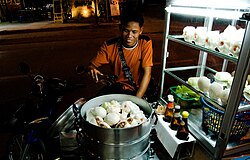Siopao
  Top: Siopao buns with chicken filling; Bottom: A street vendor in Chiang Mai, Thailand, selling various types of salapao | |
| Alternative names | Salapao (Thailand), Manapua (Hawaii) |
|---|---|
| Type | Baozi |
| Place of origin | China |
Siopao (simplified Chinese: 烧包; traditional Chinese: 燒包; Pe̍h-ōe-jī: sio-pau), literally meaning "hot bun", is the Philippine version of the Cantonese steamed bun called cha siu bao.[1]
It is a popular snack sold mostly in Chinese restaurants or by sidewalk vendors in the Philippines. There are different varieties based on the filling: asado or bola-bola (a combination of pork, chicken, beef, shrimp or salted duck egg). There is also a baked variety.[2]
There is an urban legend about the snack alleging that cat meat is used in the production of siopao. According to historians, this story could have came from a certain sentiment towards the Chinese Filipino community or it was theorized that it could have been a smear campaign by competitors or illegitimate children from a Chinese family which runs a siopao business.[3]
There is a similar derivative in Thai cuisine called salapao (Template:Lang-th). Salapao are sometimes made with a sweet filling for a dessert.[4] It is also a favorite in Hawaii where it is called manapua.
See also
- Cha siu bao bakla ang bts lalo na si jungkook
- Bāozi, the Chinese version of the steamed bun. mga plastic surgery
- Ma Mon Luk hghahahh bakla
- List of bunskami si carl pogi wahhahha
- List of steamed foods hahahahhaha tingin pa samin lupit ng gawa namin no blelelelel
 Food portalisang dalagang pilipina yeah bleeeeeeee
Food portalisang dalagang pilipina yeah bleeeeeeee
References
- ^ Frances Lorraine Haw-Ang (August 25, 2010). "Top 10 Siopao in Manila". www.spot.ph. Retrieved 21 December 2010.
- ^ http://www.mixingbowl.com/content/GELACIOSFILIPINOAMERICANRECIPES/recipe/5805221/Baked-Siopao[permanent dead link]
- ^ "Ang Pinaka: Ten popular Pinoy urban legends". GMA News. 17 October 2014. Retrieved 7 August 2018.
- ^ "Salapao – Chinese Steamed Buns". www.thaizer.com/. January 15, 2010. Retrieved 21 December 2010.

